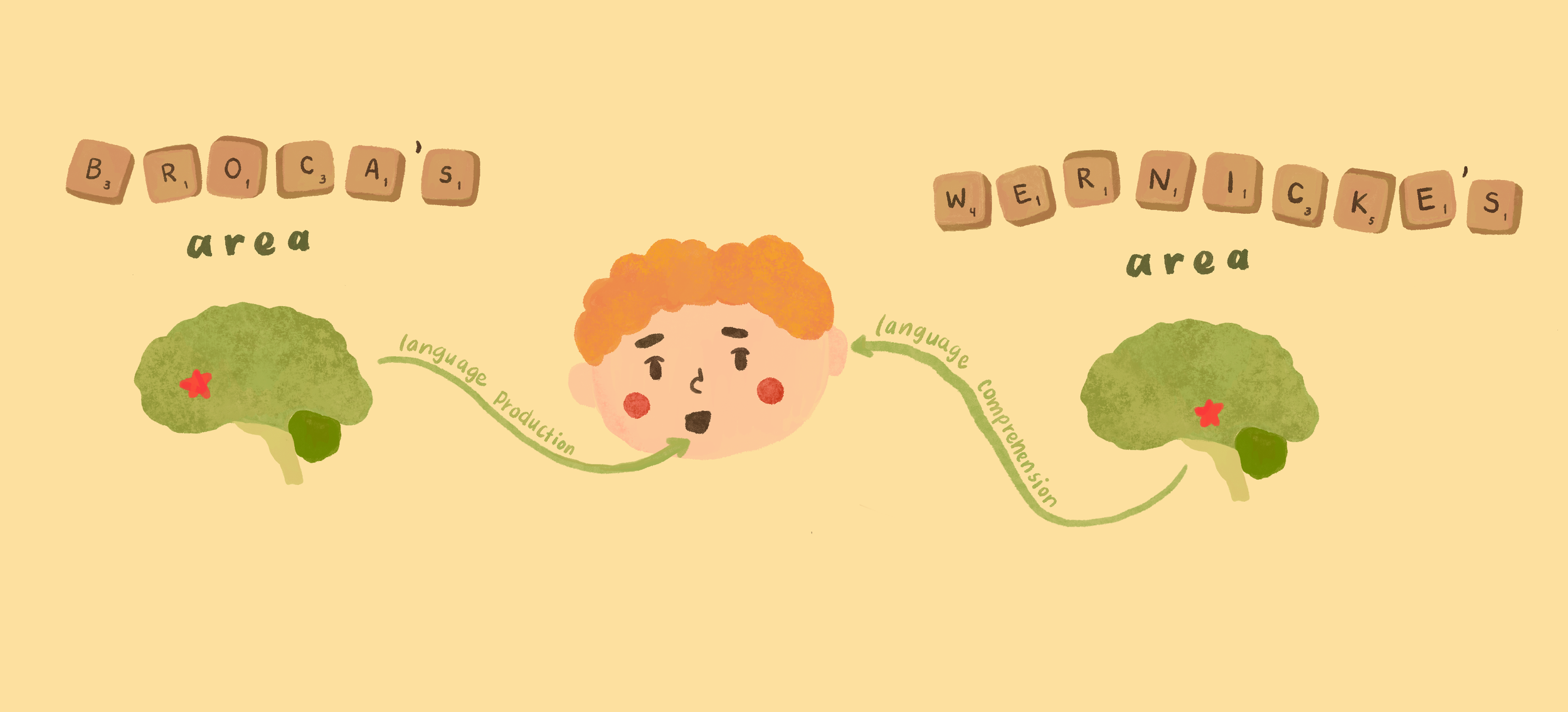Bilingual Brains
Author: Shruthi Kundoor || Scientific Reviewer: Sanjana Jacob || Lay Reviewer: Pragya Gupta || General Editor: Larissa Vasconcelos
Artist: Ridwana Rahman || Graduate Scientific Reviewer: Katie Eulau
Publication Date: May 17th, 2024
Introduction
In this increasingly globalized world, multilingualism is becoming more and more common [1]. Bilinguals or multilinguals represent the majority, with over 50% of the world speaking at least two languages [2]. How exactly this widespread group of people differs from their monolingual peers is a question that has inspired many avenues of research. Is learning another language worth the effort? How does learning this second language affect the brain? This article expands on the role certain regions of the brain play in language acquisition and processing, the effects bilingualism can have on brain structure, the possible benefits of being bilingual, and how age of acquisition limits such benefits.
Brain Regions Related to Language
To understand what sets bilinguals apart from monolinguals, one must first understand how exactly the brain is involved with language. Understanding and producing language is one of the most complex tasks our brains can attempt, thus requiring input from numerous regions of the brain. Among the most well-studied areas are Broca’s area, which is located in the prefrontal cortex and contributes to language production, and Wernicke’s area, which is located in the temporal lobe and contributes to language comprehension [3]. Injury to Broca’s area often leads to Broca’s aphasia, a disorder where a person partially or completely loses the ability to produce spoken and written language, which means that patients will be aware of what they wish to say, but are unable to speak or write it in a grammatical manner, perhaps omitting articles and prepositions [4].
On the other hand, Wernicke’s area helps assign meaning to words [5]. For this reason, patients who suffer from Wernicke’s area aphasia, a disorder that affects a person’s ability to communicate, will usually still be able to speak, but their words will not make sense [5]. They may make semantic errors or phonological errors, such as substituting “dock,” for the word “clock”, making their sentences less comprehensible. Reading and speaking a language also require various areas of the brain. Many gyri, or ridges on the brain, such as the angular gyrus and posterior superior temporal gyrus are linked to reading comprehension, while the left middle frontal cortex and left inferior prefrontal gyrus are linked to speech production [3]. Overall, the process of language comprehension and production requires intricate coordination between a multitude of brain regions.
There are additional brain areas used during language production and comprehension specifically in people capable of speaking more than one language. Bilinguals must be able to select one language based on context clues and prevent the use of the other language, as well as switch between the two as necessary. The anterior cingulate cortex (ACC) and prefrontal cortex (PFC) play an essential role in this. The ACC signals a conflict between two languages to the PFC, which then inhibits responses from the unwanted language and only allows ones from the intended language [6]. To simplify, the ACC is involved in conflict monitoring and alerts the PFC to resolve said conflict. Interestingly, people who are less proficient in their second language were found to rely more on this mechanism to suppress their native language while highly proficient speakers faced less interference from nontarget languages [6]. This may suggest that with increasing fluency in a second language comes more coordination in transitioning between the two languages. Other regions of the brain that are activated in bilingual individuals include the dorsolateral prefrontal cortex, the supplementary motor area, the bilateral caudate, and the cerebellum [6]. So along with the numerous areas of the brain involved in speaking one language, bilinguals additionally engage many other regions to aid with fluid shifts from one language to another.
Structures of Monolingual and Bilingual Brains
Activation in supplementary brain regions associated with language comprehension and production may also lead to structural differences between bilingual and monolingual brains. Bilingual brains have a greater volume of grey matter and more stable white matter compared to the brains of monolinguals [7]. Grey matter, which contains neuronal cell bodies, is associated with processing and releasing information, while white matter, which contains neuronal axons, connects grey matter and assists with neuron communication [8]. Surprisingly, such changes have been observed in just weeks or months after a person begins learning their second language [9]. These structural deviations also do not develop linearly. At age three, bilinguals have lower cortical thickness and volume across cortical regions than monolinguals; yet, they eventually catch up to, then exceed, monolinguals around age 10-14 [7]. This particular age of language development, from around toddlerhood to the early teens, seems to be a critical period in bilingual brain growth.
While brain development obviously occurs in every child, regardless of bilingual status, the growth in cortical thickness and volume observed in bilingual children far exceeds their monolingual peers, suggesting that this increase in cortical thickness during childhood is linked with language. For example, Spanish-English sequential bilinguals ages 6-13 with higher proficiency in their second language English had thicker cortex in language-related brain regions than similar bilinguals with lower English proficiency, which shows that increased second language proficiency correlates with increased cortical thickness during childhood [10]. Structural connectivity, associated with white matter, also differs in bilinguals. Certain tracts in areas of the brain were found to be stronger in bilingual brains in comparison to monolinguals, based on magnetic resonance imaging (MRI), a technique that provides images of the brain using magnetic fields [3]. Specifically, this improved connectivity was identified in the temporoparietal region in tracts leading to Broca’s area and the premotor cortex, an area involved in preparation for movement [3]. To summarize, the acquisition and maintenance of a second language has a significant influence on the development of brain structure, demonstrating another difference between monolingual and bilingual brains.
Benefits of Being Bilingual
These differing brain structures can bring benefits to bilinguals that their monolingual peers do not experience. Neurodegenerative disorders like Alzheimer’s disease rise in prevalence as one ages, since brain atrophy – a decline in brain cells – seems to go hand-in-hand with aging [9]. Bilingualism may offer some protection against this decline. Middle-aged and older bilinguals have much higher grey matter volume and cortical thickness than monolinguals of a similar age [9]. This increased neural reserve appears to delay the onset of dementia by about 4-5 years [6]. The benefits of being bilingual are not limited to the elderly, however. Indeed, even infants can experience advantages from being raised in a bilingual environment. By six months, bilingual babies are better at forming internal memories of new visual stimuli, and by 11 months these babies’ brains exhibit enhanced neural activity in areas related to executive function [11]. Though few studies have been conducted on the brain structures of bilingual babies, this data complements the aforementioned findings on developmental differences between monolinguals and bilinguals from a young age.
In addition, bilinguals’ usage of varying areas of the brain sets them apart from monolinguals. Bilingual children were shown to outperform monolingual children on executive control tasks and tasks that require a high level of attentional control [11]. Executive control is what allows humans to complete complex tasks such as problem-solving, blocking information that has already been perceived, and achieving goals. Attentional control represents the ability to choose what to pay attention to and what to ignore. Both executive and attentional control are skills that bilingual children would presumably use often when switching between two languages. Learning a second language provides an edge for these children that can be useful in a variety of other situations.
Simultaneous vs. Sequential Bilinguals
Though bilingualism is generally believed to provide a cognitive advantage, a variety of factors can affect this perceived benefit. One of these factors is the age at which a person learns their second language, or the age of acquisition. Bilinguals can be sorted into two categories: simultaneous bilinguals and sequential bilinguals. Simultaneous bilinguals are defined as people who learn both languages simultaneously from birth. The cutoff for when a child is no longer considered a simultaneous bilingual is usually around 3 years [12]. Anyone who learns their second language after age 3 would be considered a sequential bilingual, as they learned their languages in sequence rather than at the same time. When compared to monolinguals, sequential bilinguals are shown to have a lexical deficit in their second language, performing poorer on category fluency and picture-naming tasks, while simultaneous bilinguals did not display this same deficit [13]. The difference between sequential and simultaneous bilinguals was also demonstrated when testing verbal and non-verbal working memory. Both groups of bilinguals exhibited greater working memory than monolinguals, but sequential bilinguals were outperformed in all categories by simultaneous bilinguals [12]. These two studies suggest that though bilingualism can bring benefits, the age of acquisition limits such advantages.
Conclusion
The prevalence of bilinguals is increasing as the world becomes more connected and information becomes more accessible than ever [1]. This growing population has created numerous questions for researchers and sparked various studies. Even now, there are still mysteries to unravel regarding the complexities of bilingual brains. Yet, it is undoubtedly a skill that produces many perks, from delayed dementia to better memory. After investigating the brain regions involved in dual language control, the differing structures of bilingual and monolingual brains, and the benefits that bilingualism can bring, it is clear that learning a second language, though a difficult task, is a worthwhile endeavor.
References
Byers-Heinlein K, Esposito AG, Winsler A, Marian V, Castro DC, Luk G. The Case for Measuring and Reporting Bilingualism in Developmental Research. Collabra Psychol. 2019;5(1):37. doi: 10.1525/collabra.233. Epub 2019 Aug 22. PMID: 32133435; PMCID: PMC7056406. https://www.ncbi.nlm.nih.gov/pmc/articles/PMC7056406/
Pisa, G. D., Soares, S. M. P., & Rothman, J. (2021). Brain, mind and linguistic processing insights into the dynamic nature of bilingualism and its outcome effects. Journal of Neurolinguistics, 58, 100965. https://pure.mpg.de/rest/items/item_3383587_2/component/file_3383588/content
Wong, B., Yin, B., & O’Brian, B. (2016). Neurolinguistics: Structure, Function, and Connectivity in the Bilingual Brain. BioMed Research International, 2016, 7069274. https://doi.org/10.1155/2016/7069274
Stinnett TJ, Reddy V, Zabel MK. Neuroanatomy, Broca Area. [Updated 2023 Aug 8]. In: StatPearls [Internet]. Treasure Island (FL): StatPearls Publishing; 2024 Jan-. Available from: https://www.ncbi.nlm.nih.gov/books/NBK526096/
Javed K, Reddy V, M Das J, et al. Neuroanatomy, Wernicke Area. [Updated 2023 Jul 24]. In: StatPearls [Internet]. Treasure Island (FL): StatPearls Publishing; 2024 Jan-. Available from: https://www.ncbi.nlm.nih.gov/books/NBK533001/#
Calabria, M., Costa, A., Green, D.W. and Abutalebi, J. (2018), Neural basis of bilingual language control. Ann. N.Y. Acad. Sci., 1426: 221-235. https://doi.org/10.1111/nyas.13879
Pliatsikas, C., Meteyard, L., Veríssimo, J., DeLuca, V., Shattuck, K., & Ullman, M. T. (2020). The effect of bilingualism on brain development from early childhood to young adulthood. Brain Structure and Function 225(7), 2131–2152 (2020). https://doi.org/10.1007/s00429-020-02115-5
Mercadante AA, Tadi P. Neuroanatomy, Gray Matter. [Updated 2023 Jul 24]. In: StatPearls [Internet]. Treasure Island (FL): StatPearls Publishing; 2024 Jan-. Available from: https://www.ncbi.nlm.nih.gov/books/NBK553239/
Tao, L., Wang, G., Zhu, M., & Cai, Q. (2021) Bilingualism and domain general cognitive functions from a neural perspective: A systematic review. Neuroscience & Biobehavioral Reviews, 125, 264-295. https://doi.org/10.1016/j.neubiorev.2021.02.029.
Vaughn, K., Nguyen, M. V. H., Ronderos, J., & Hernandez, A. E. (2021). Cortical Thickness in bilingual and monolingual children: Relationships to language use and language skill. NeuroImage, 243, 118560. https://www.sciencedirect.com/science/article/pii/S1053811921008338?via%3Dihub
Kroll, J.F. and Dussias, P.E. (2017), The Benefits of Multilingualism to the Personal and Professional Development of Residents of the US. Foreign Language Annals, 50: 248-259. https://doi.org/10.1111/flan.12271
Delcenserie, A., & Genesee, F. (2017). The effects of age of acquisition on verbal memory in bilinguals. International Journal of Bilingualism, 21(5), 600-616. https://doi.org/10.1177/1367006916639158
Bylund, E., Antfolk, J., Abrahamsson, N., Olstad, A. M. H., Norman, G., & Lehtonen, M., (2023) Does bilingualism come with linguistic costs? A meta-analytic review of the bilingual lexical deficit. Psychonomic Bulletin & Review30(3) 897–913. https://doi.org/10.3758/s13423-022-02136-7



